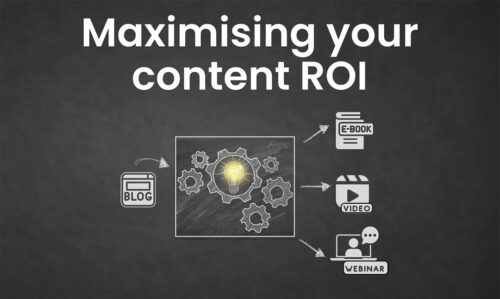The Art of Content Repurposing
Creating fresh content consistently is a challenging and time-consuming task. This is where content repurposing comes into play. Repurposing content is a strategic marketing approach that allows you to breathe new life into your existing content, extending its reach and impact with the least effort. In this blog, we’ll explore how you can make the most of your content investment.
What is content repurposing?
Content repurposing or content recycling involves reworking existing content and adapting it into different formats or mediums, so that it suits the styles and needs of different platforms. This strategy not only saves time and resources but it also expands that content’s reach to a broader audience, which means you are likely to score more shares and reinforce your message – ideal for your content strategy!
Where do I start?
Audit your content – see which of your blogs or videos have been popular by checking the views, downloads etc as these are more likely to be shared further. But at the same time don’t disregard a blog that didn’t do so well, as maybe by reinventing it in a new format it will be more successful.
Outline your objective – do you want to repurpose a piece of content to target new audiences? Or do you want to convert your personas who might be at different stages of the buying cycle? For example, you could repurpose a well performing blog into an infographic for awareness, an ebook for consideration and an on-demand webinar for the decision stage.
Leverage your exposure – of course you want to maximise your content’s exposure and gain better results. But please don’t be overwhelmed, start by spinning one piece of content into some new formats, upload to one or two other platforms and see how it performs.
The benefits of content repurposing
- Efficiency – creating original content from scratch requires considerable time and resources. Repurposing content allows you to make the most of your existing assets thus reducing your efforts.
- Expanding your reach – different people consume content in different ways. By repurposing content into various formats, you can reach a wider audience who might not otherwise get to see or enjoy your content, as it may also be presented in a preferred way that they can appreciate.
- Improved SEO – search engines value fresh content, but that doesn’t mean you have to start from scratch every time. By updating and republishing older pieces, you can boost your website’s SEO and maintain a strong online presence. You are not duplicating your content, you are only trying to increase the awareness of your brand – so you aren’t violating Google’s guidelines.
- Reinforce your messaging – repetition is a powerful tool. Repurposing content enables you to reinforce key messages and ideas, making them more memorable for your audience.
Types of content repurposing
There are many ways to repurpose content. Here are some ideas for you to consider:
- Blogs to social media posts – deconstruct your blogs by extracting key points, quotes, or statistics and share them on social media platforms as a series of videos, a listicle or a meme.
- Webinars to videos – if you’ve conducted a webinar or online workshop, you can convert the recording into a series of short video clips or tutorials. These can be uploaded to platforms like YouTube or embedded into blog posts.
- Podcast transcripts – if you have a podcast, transcribe the episodes and turn them into an email series, blog posts or an article. This not only expands your content but the different formats makes it more accessible to wider audiences.
- Ebooks from blog posts – compile a series of related blog posts into an ebook or a whitepaper. This can serve as a valuable downloadable lead magnet or a new resource to add to your website.
- Infographics from research – have you conducted a survey or gathered data for a report? Bring it to life by repurposing it into impactful infographics or listicles. These types of content are highly shareable and can simplify complex information.
- Email newsletter content – transform your email newsletter content into blog posts, social media updates or an article. Alternatively, I have recreated my client’s email newsletter into a LinkedIn monthly newsletter. We generated over 100 more subscribers with the first issue!
Tips for effective content repurposing
Quality over quantity – repurposing should enhance your content’s value, not dilute it. Focus on maintaining quality in every format.
Tailor it for the platform – different platforms have different content requirements and audience expectations. Adapt your content accordingly.
Keep it relevant – ensure that your repurposed content remains relevant and up-to-date. Update statistics, links and current information as needed.
Cross-promote – when repurposing on to different platforms, cross-promote your content as it will drive more traffic and increase engagement.
Track performance – use analytics to measure the performance of your repurposed content. This helps you to use the insights and identify what works and what doesn’t.
Content repurposing is a smart and sustainable approach to content marketing. It not only saves time and resources but also helps you make the most of your existing content assets. By adapting your content into various formats and platforms, you can reach a wider audience, reinforce key messages and maintain a strong online presence.
So, don’t let your valuable content go to waste – repurpose it and watch your reach and impact grow. Need some advice on your content strategy or help with producing compelling content?
Get in touch at christina@hippocampus.marketing and let’s have an informal chat.



